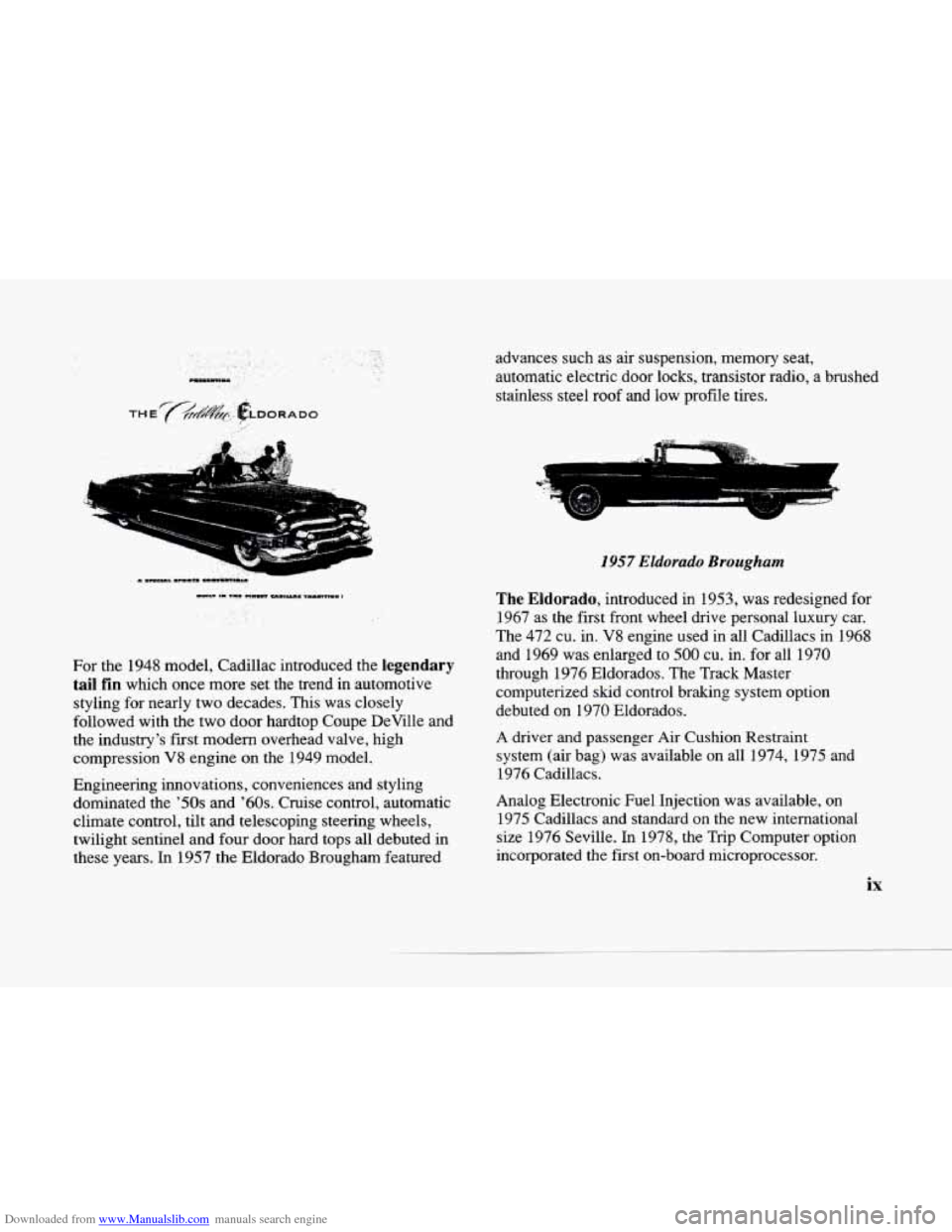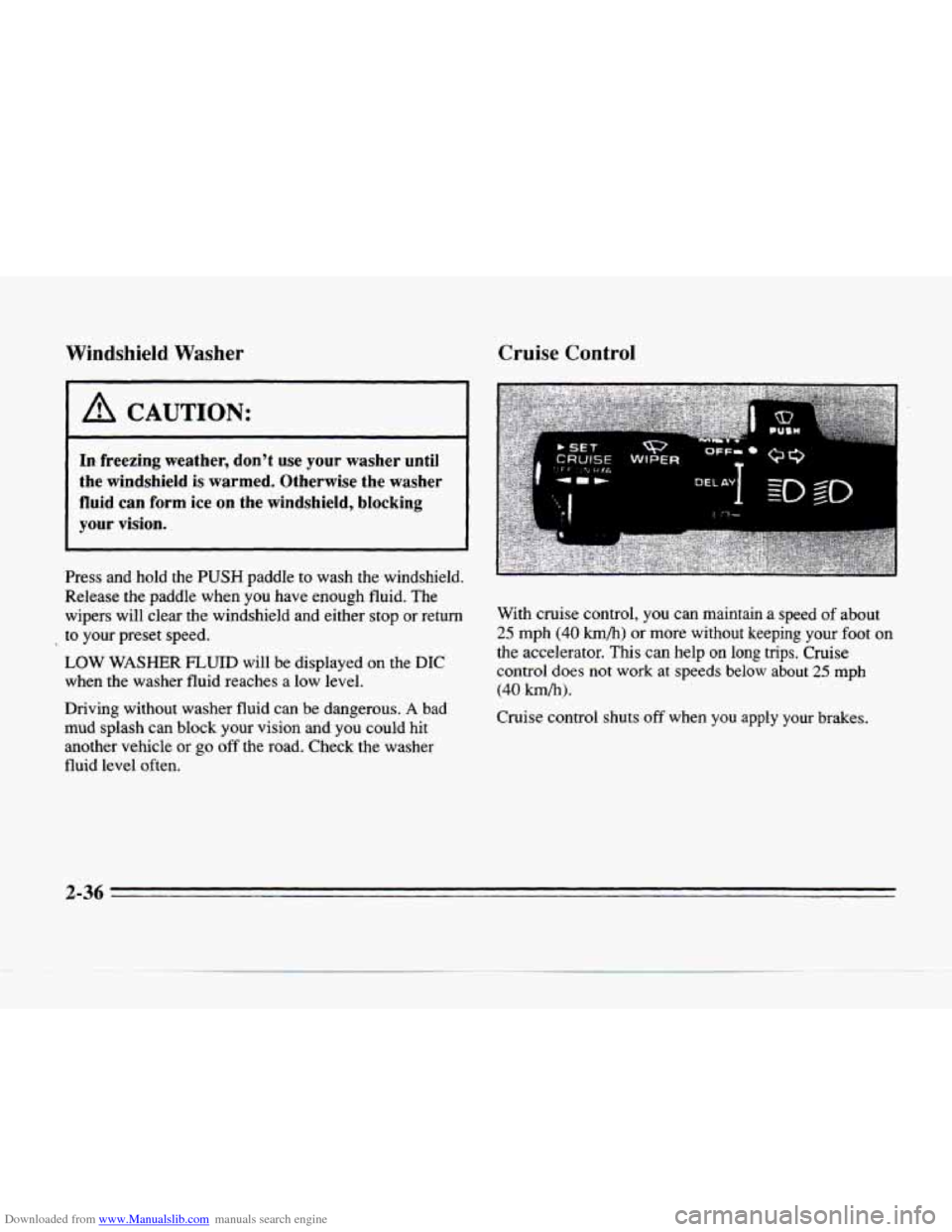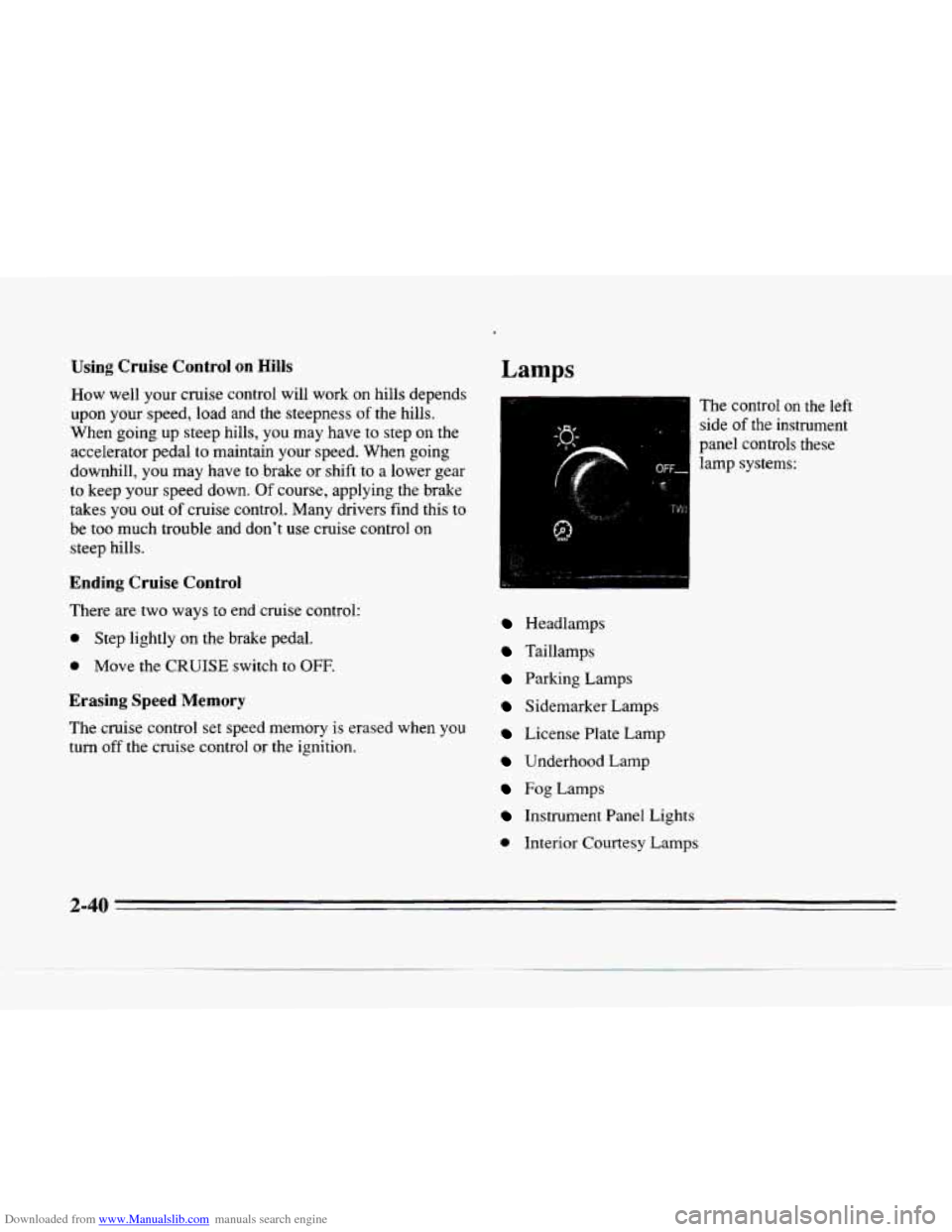1996 CADILLAC SEVILLE cruise control
[x] Cancel search: cruise controlPage 10 of 354

Downloaded from www.Manualslib.com manuals search engine c . . .- . '.
For the 1948 model, Cadillac introduced the legendary
tail fin which once more set the trend in automotive
styling for nearly two decades. This was closely
followed with the two door hardtop Coupe DeVille and
the industry's
first modern overhead valve, high
compression
V8 engine on the 1949 model.
Engineering innovations, conveniences and styling
dominated the
'50s and '60s. Cruise control, automatic
climate control, tilt and telescoping steering wheels,
twilight sentinel and four door hard tops all debuted in
these years. In 1957 the Eldorado Brougham featured advances such
as air suspension,
memory seat,
automatic electric door locks, transistor radio, a brushed
stainless steel roof and low profile tires.
7
1957 Eldorado Brougham
The Eldorado, introduced in 1953, was redesigned for
1967 as the first front wheel drive personal luxury
car.
The 472 cu. in. V8 engine used in all Cadillacs in 1968
and 1969 was enlarged to
500 cu. in. for all 1970
through 1976 Eldorados. The Track Master
computerized skid control braking system option
debuted on 1970 Eldorados.
A driver and passenger Air Cushion Restraint
system (air bag) was available
on all 1974, 1975 and
1976 Cadillacs.
Analog Electronic Fuel Injection was available, on
1975 Cadillacs and standard
on the new international
size 1976 Seville. In 1978, the Trip Computer option
incorporated the first on-board microprocessor.
ix
Page 95 of 354

Downloaded from www.Manualslib.com manuals search engine Windshield Washer
I A CAUTION:
In freezing weather, don't use your washer until
the windshield is warmed. Otherwise the washer
fluid can form ice on the windshield, blocking
your vision.
Press and hold the PUSH paddle to wash the windshield.
Release the paddle when you have enough fluid.
The
wipers will clear the windshield and either stop or return
to your preset speed.
LOW WASHER FLUID will be displayed on the DIC
when the washer fluid reaches a low level.
Driving without washer fluid can be dangerous.
A bad
mud splash can block your vision and you could hit
another vehicle
or go off the road. Check the washer
fluid level often.
Cruise Control
With cruise control, you can maintain a speed of about
25 mph (40 h/h) or more without keeping your foot on
the accelerator. This can help on long trips. Cruise
control does not
work at speeds below about 25 mph
(40 km/h).
Cruise control shuts off when you apply your brakes.
2-36
Page 96 of 354

Downloaded from www.Manualslib.com manuals search engine h
A CAUTION:
Cruise control can be dangerous where you
can’t drive safely at
a steady speed. So,
don’t use your cruise control on winding
roads or
in heavy traffic.
Cruise control can
be dangerous on
slippery roads. On such roads, fast changes in tire traction can cause needless wheel
spinning, and you could lose control. Don’t
use cruise control on slippery roads.
If your vehicle is in cruise control when the traction
control system begins to limit wheel spin, the cruise
control will automatically disengage. (See “Traction
Control System” in the Index.) When road conditions
allow you
to safely use it again, you may turn the cruise
control back
on.
Setting Cruise Control
A CAUTION:
If you leave your cruise control switch on when
you’re not using cruise,
you might hit a button and
go into cruise when you don’t want to. You could
be startled and even lose control.
Keep the cruise
control switch
OFF until you want to use it.
n ‘ .,...., -
1. Move the cruise control
switch to ON.
2. Accelerate to the speed you want.
2-37
Page 97 of 354

Downloaded from www.Manualslib.com manuals search engine A
message will display on
the
DIC.
4. Remove your foot from the accelerator pedal.
Resuming a Set Speed
* SET wg N
CRUISE WIPER
Remember, if you hold the switch at R/A longer than
half a second, the vehicle will accelerate until
you
release the switch or apply the brake. You could be
startled and even lose control. So unless you want to
go faster, don't hold the switch at R/A.
2-38
e
Page 98 of 354

Downloaded from www.Manualslib.com manuals search engine Increasing Speed While Using Cruise Control
There are two ways to increase your speed. Here’s
the first:
1. Use the accelerator pedal
to go to a higher speed.
2. Push the button at the end of the lever and then
release the button and the accelerator pedal. You’ll
now cruise at the higher speed.
Here’s the second
way to increase speed:
Move the cruise switch from ON to R/A. Hold it
there until you reach a desired speed and then release
the switch.
To increase your speed in very small amounts, move
the switch to
R/A. Each time you do this, your
vehicle will
go about 1 mph (1.6 h/h) faster.
The accelerate feature will
only work after you have set the
cruise control speed by pushing the
SET CRUISE button.
Reducing Speed While Using Cruise Control
There are two ways to reduce your speed while using
cruise control:
Push in the button at the end of the lever until
you reach a desired lower speed, then release it.
A CRUISE ENGAGED message will then display.
To slow down in very small amounts, push the
button
for less than half a second.’Each time you do
this, you’ll
go 1 mph (1.6 km/h) slower.
Passing Another Vehicle While Using Cruise Control
Use the accelerator pedal to increase your speed. When
you take your foot
off the pedal, your vehicle will slow
down to the cruise control speed
you set earlier.
2-39
Page 99 of 354

Downloaded from www.Manualslib.com manuals search engine Using Cruise Control on Hills
How well your cruise control will work on hills depends
upon your speed, load and the steepness
of the hills.
When going up steep hills, you may have to step
on the
accelerator pedal
to maintain your speed. When going
downhill, you may have to brake
or shift to a lower gear
to keep your speed down.
Of course, applying the brake
takes you
out of cruise control. Many drivers find this to
be too much trouble and don’t use cruise control on
steep hills.
Ending Cruise Control
There are two ways to end cruise control:
0 Step lightly on the brake pedal.
0 Move the CRUISE switch to OFF.
Erasing Speed Memory
The cruise control set speed memory is erased when you
turn off the cruise control or the ignition.
Lamps
OFF,
The control on the left
side
of the instrument
panel controls these lamp systems:
Headlamps
Taillamps
Parking Lamps
Sidemarker Lamps
License Plate Lamp
Underhood Lamp
Fog Lamps
Instrument Panel Lights
0 Interior Courtesy Lamps
4
2-40
Page 141 of 354

Downloaded from www.Manualslib.com manuals search engine CHECK COOLANT LEVEL - 02: This message will
appear when there is a low level of engine coolant. Have
the cooling system serviced by a Cadillac technician
as
soon as possible.
CHECK FUEL GAGE - 39: This message will appear
when the fuel supply is less than four gallons
(15.2 L)
and the display is turned off (digital clusters only).
CHECK OIL LEVEL - 36: For correct operation of
the low oil sensing system, your vehicle should be on a
level surface.
A false CHECK OIL LEVEL message
may appear if the vehicle
is parked on grades. The oil
level sensing system does not check for actual oil level
if the engine has been off for
a short period of time, and
the oil level is never sensed while the engine is running.
If the CHECK OIL LEVEL message appears, and your
vehicle has been parked on level ground with the engine
off
for at least 30 minutes, the oil level should be
checked by observing the
oil dipstick. Prior to checking
the oil level be sure the engine has been off for five
minutes and your vehicle
is on a level surface. Then
check the dipstick and add oil if necessary. See “Engine
Oil” in the Index.
CHECK WASHER FLUID - 25: This message will
appear
for several seconds indicating that you need
washer solvent.
CRUISE ENGAGED - 43: This message will
appear for
a few seconds when you select a speed at
which to cruise.
DOOR OPEN - 141: The passenger‘s door is open or
ajar when this message appears. The vehicle’s engine
must be running and the transaxle not
in PARK (I?) for
this message to display. A chime will also sound when
the vehicle’s speed is greater than
5 mph (8.1 km/h).
DRIVER DOOR OPEN - 140: This message
will display when the vehicle is being shifted out of
PARK (P) with the engine running to signal that the
driver’s door
is open or ajar. A chime will also sound
when the vehicle’s speed
is greater than 5 mph
(8.1 km/h).
ENGINE COOLANT HOT-IDLE ENGINE - 44:
This message will appear when the engine coolant
temperature is over
248 “F ( 1 24°C). To avoid added
strain on a hot engine, turn
off the climate control
system. Stop and allow your vehicle
to idle until it cools
down
or the message is removed. If it does not cool
down, turn off the engine and
have it serviced before
driving it again. Severe engine damage can result from
an overheated engine. See
“Engine Overheating” in
the Index.
2-82
Page 191 of 354

Downloaded from www.Manualslib.com manuals search engine Remember: Anti-lock doesn’t change the time you need
to get your foot up to the brake pedal or always decrease
stopping distance. If
you get too close to the vehicle in
front
of you, you won’t have time to apply your brakes
if that vehicle suddenly slows or stops. Always leave
enough room up ahead to stop, even though you have
anti-lock brakes.
Using Anti-Lock
Don’t pump the brakes. Just hold the brake pedal down
and let anti-lock work for
you. You may hear the
anti-lock pump or motor operate, and feel the brake
pedal pulsate, but this is normal.
Traction Control System.
Your vehicle has a traction control system that limits
wheel spin. This is especially useful in slippery road
conditions. The system operates only if
it senses that one
or both of the front wheels are spinning or beginning to
lose traction. When this happens, the system works the
front brakes and reduces engine power to limit wheel
spin.
The TRACTION ACTIVE message will display on the
Driver Information Center when the traction control
system is limiting wheel spin. See “Driver Information
Center Messages’’ in the Index.
You may feel or hear the
system working, but this
is normal.
If your vehicle is in cruise control when the traction
control system begins to limit
wheel spin, the cruise
control will automatically disengage. When road
conditions allow you to safely
use it again, you may
re-engage the cruise control.
(See “Cruise Control’’ in
the Index.)
c
4-8